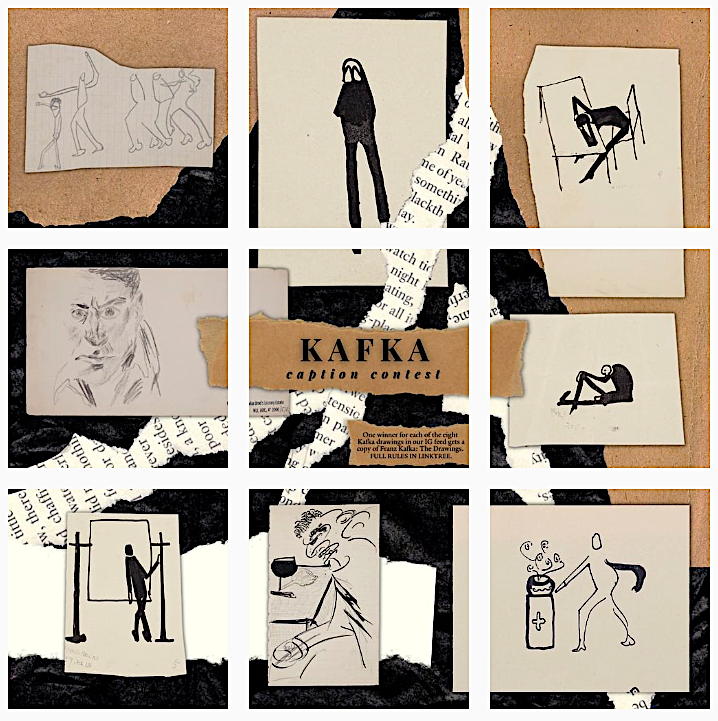
Imagine if Franz Kafka were charged with picking the winning entries in The New Yorker’s weekly cartoon caption contest.
The punchlines might become a little more obscure.
If that idea fills you with perverse pleasure, perhaps you should toddle over to Yale University Press’s Instagram to contribute some possible captions for eight of the inky drawings the tortured author made in a black notebook between 1901 and 1907.
The intended meaning of these images, included in the new book, Franz Kafka: The Drawings, are as up for grabs as any uncaptioned cartoon on the back page of The New Yorker.
In Conversations with Kafka, author Gustav Janouch recalled how their significance proved elusive even to their creator, and also the frustration his friend expressed regarding his artistic abilities:
I should so like to be able to draw. As a matter of fact, I am always trying to. But nothing comes of it. My drawings are purely personal picture writing, whose meaning even I cannot discover after a time.
Kafka seems to have gone easier on himself in a 1913 letter to fiancée Felice Bauer:
I was once a great draftsman, you know… These drawings gave me greater satisfaction in those days—it’s years ago—than anything else.
Artist Philip Hartigan, who referenced the drawings in a journal and sketchbook class for writing students nails it when he describes how Kafka’s “quick minimum movements … convey the typical despairing mood of his fiction in just a few lines.”
You have until June 13 to make explicit what Kafka did not by leaving your proposed caption for each drawing as a comment on Yale University Press’s Instagram, along the hashtag #KafkaCaptionContest.
Winners will receive a copy of Franz Kafka: The Drawings. Entries will be judged by editor Andreas Kilcher of and theorist Judith Butler, who contributed an essay that you might consider mining for material:
Was it a muffled death? Or perhaps it was no death at all, just a tumbling of intercourse, a sexual flurry?
Yes, that might go nicely with Kafka’s drawing of a seated figure collapsed over a table, below.
https://images.app.goo.gl/mGfZzLcpRXuyqqU68
Some alternate proposals from contest hopefuls:
I needed to bathe my battered knuckles with my tears.
He studied his newly acquired rare stamp with a powerful loupe.
How can I make sure that all my letters and papers will be destroyed after my death? I know — I’ll ask my closest friend to take care of it!
This last is a reference to Kafka’s literary executor, Max Brod, who defied Kafka’s explicit wish that all of his work be burned upon his death, save The Metamorphosis, and five short stories: The Judgment, The Stoker, In the Penal Colony, A Country Doctor and A Hunger Artist.

Brod cut Kafka’s drawing of the standing figure, above, from his sketchbook and kept in an envelope with a few others. Some of the current caption suggestions for this haunting, never before seen image:
my face is an umbrella to my tears
I couldn’t face myself.
I am the Walrus goo goo g’joob
https://images.app.goo.gl/e6v8xbuRin3qWcS56
Of the eight drawings in the caption contest, Drinker, may offer the most narrative possibilities. A representative sampling of the inventiveness that’s come over the transom thusfar:
I, period
Angered by the impudence of the cabernet, i had only the courage to berate its shadow
Waiter! There’s a roach in my wine.
Enter Yale University Press’ Kafka Caption Contest (or get a feel for the competition) here. Entries will be accepted through June 13. Full contest rules are here. Good luck!
Explore the drawings and other contents of Franz Kafka’s black notebook here.
Purchase Franz Kafka: The Drawings, the first book to publish the entirety of the author’s graphic output, here.
- Ayun Halliday is the Chief Primatologist of the East Village Inky zine and author, most recently, of Creative, Not Famous: The Small Potato Manifesto. Follow her @AyunHalliday.


Leave a Reply